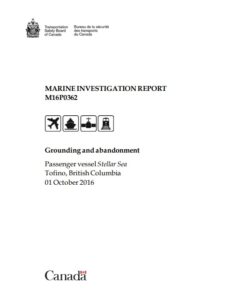The Transportation Safety Board of Canada (TSBC) issued an investigation report on the grounding of the Canadian-flagged passenger vessel ‘Stellar Sea’ in October 2016, noting that ti was the Master’s loss of positional awareness in combination with insufficient passage planning that led to the accident.
The incident
On the afternoon of 01 October 2016, ‘Stellar Sea’ with 28 people on board, departed Tofino, British Columbia, on a bear-watching excursion. At approximately 1744 Pacific Daylight Time, in Warn Bay, the vessel struck a charted rock and went aground. The passengers and crew abandoned the vessel and were evacuated with the assistance of the passenger vessels Pacific Springs and Rip Tide. Two passengers sustained minor injuries. No pollution was reported.
Probable cause
The investigation found that the Stellar Sea ran aground because the master lost positional awareness, due to the focus that was required to search the coastline for wildlife while the vessel made way in confined shallow waters. The investigation also determined that there was insufficient passage planning prior to the occurrence voyage: neither the company nor the master assessed the risks of the planned voyage. Therefore, no risk mitigation was in place to guide the master’s conduct of the vessel during the tour.
Findings
- There was insufficient passage planning prior to the occurrence, as it did not include strategies to identify and mitigate the risks posed by potential navigational hazards.
- There was no lookout posted and, because the master was required to perform multiple continuous and sequential tasks, no one saw the rock in time to prevent the vessel from running aground.
- While in shallow waters, the master was looking through the binoculars and closing in on the nearby rock. As the binoculars temporarily removed the master’s peripheral vision, the master did not have effective positional awareness at that time.
- After spotting a bear, the master lowered the binoculars and redirected the vessel toward the bear without first verifying the vessel’s position in relation to the rock.
- The attentional focus required by the master to keep the bear in sight and get closer to it quickly prevented the master from visually reacquiring the vessel’s position in time to navigate around the rock as he had done on previous voyages.
- The master’s mental map of the rock did not include the underwater shape and extent of the rock. Therefore, the master’s practice was to navigate close to the rock because the risk of this navigation practice was not assessed.
- The master did not see that the rock was close on the starboard side in time to take adequate evasive action before the vessel ran aground.
- The ebbing tide caused the vessel to heel progressively to port.
- The master was concerned that the Stellar Sea might capsize or slide off the rock, so he directed the passengers to abandon the vessel onto the rock on the starboard side.
- If companies or masters do not alert search-and-rescue resources in a timely manner, there is an increased risk that the response will not be timely, effective, or coordinated.
- In Clayoquot Sound, neither the Department of Fisheries and Oceans nor the British Columbia Ministry of Forests, Lands, and Natural Resource Operations monitors marine vessels that conduct tours for sighting terrestrial wildlife.
- Although the emergency position indicating radio beacon was easily accessible, it was not manually activated during the occurrence.
Recommendations
In addition, on 25 October 2015, the passenger vessel Leviathan II,Footnote45 with 27 people on board, capsized off Plover Reefs in Clayoquot Sound, British Columbia, while on a whale-watching excursion. There were 6 fatalities. It was determined that the company had not implemented risk management processes to identify and address environmental hazards in the area.
Therefore, the Board recommended that the Department of Transport require commercial passenger vessel operators to adopt explicit risk management processes, and develop comprehensive guidelines to be used by vessel operators and Transport Canada inspectors to assist them in the implementation and oversight of those processes.
Further details may be found herebelow:
































































